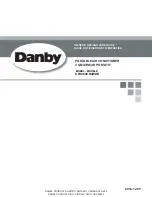
GAS PIPING
The appliance and its individual shutoff valve must be discon-
nected from the gas supply piping system during any pressure
testing of that system at test pressures in excess of 1/2 psig
(3.5 kPa).
The gas supply line should be routed through the bottom hole
provided on the left side of the unit. Sizing and installation of the
supply gas line should comply with local utility requirements.
The gas supply should be a separate line, installed in accordance
with the National Fuel Gas Code, ANSI Z223.1- or CAN/CGA-
B149.1 Natural Gas Installation Code - (latest editions).
Some utility companies require pipe sizes larger than the
maximum sizes listed. Using the properly sized wrought iron,
steel or approved flexible pipe, make gas connections to the
unit. Installation of a drop leg and ground union is required.
Refer to Figure 6.
For the purpose of input adjustment, the minimum inlet gas
pressure must be equal to or greater than that shown on the
rating label.
ENGINE EXHAUST/VENT HOOD INSTALLATION
The engine exhaust hose (blue flexible hose) is factory shipped
behind the left hand access panel. Remove the left hand
access panel, push the hose through the extruded hole in the
fixed upper panel on the left side until it extends 6" beyond the
panel. (Refer to Figure 7).
Insert the stainless steel tip provided into the hose until about
1" of tube is left showing. Clamp hose to hood using clamp and
screws provided with vent hood.
The vent hood is shipped with the unit, inside the engine
compartment. Remove the hood from the engine compartment.
Install the vent hood as shown in Figure 7.
REFRIGERANT TUBING CONNECTIONS
The outdoor unit has reusable service valves on both the liquid
and vapor connections. Both valves are shipped closed. Use
the Schrader ports on these valves to process the line connec-
tions.
Do not open until the indoor unit linesets are brazed,
leak-tested and evacuated. The total system refrigerant
charge includes the 3-ton indoor unit charge and charge for 15
ft. of 5/16" & 3/4" lineset. See chart below for specific data.
Serious service problems can be avoided by taking adequate
precautions to assure an internally clean and dry system.
Always use refrigeration-grade copper tubing that is internally
clean and dry for refrigerant lines. Use clean hard drawn copper
tubing where no appreciable amount of bending around an
obstruction is necessary. If soft copper is used, care must be
taken to avoid sharp bends which may cause a restriction. The
vapor lines must be insulated with a minimum of 1/2" insulation
(Arm-A-Flex or equivalent).
FIGURE 7 - VENT HOOD INSTALLATION
ENGINE VENT HOOD
HOSE
TIP
DROP
LEG
GROUND JOINT UNION
TO GAS
SUPPLY
EXTERNAL MANUAL
SHUTOFF VALVE
FIGURE 6 - GAS LINE ARRANGEMENT
NOTE: An accessible manual shutoff valve (ANSI
Z21.15 or CAN1-9.1 approved) must be installed up-
stream of the unit gas controls and within 6 feet of the
unit. A 1/8" NPT plugged tapping, accessible for test
gauge connection must be installed immediately up-
stream of the gas supply connection to the unit.
NOTE: A length of flexible gas line may be required by
some local codes to reduce gas line vibration.
WARNING: Compounds used on threated joints of gas
piping must be resistant to the action of liquified petro-
leum gases. After connections have been made, leak-
test all pipe connections.
WARNING: Do not use an open flame or other source of
ignition for leak testing. Set the manual gas valve to the
OFF position.
CAUTION: Clearances around outdoor unit are re-
quired to provide adequate combustion and ventilation
air. Refer to Figure 4.
CAUTION: Be sure only the hose and not the steel tube
is in contact with the hood clamp
CAUTION: Dry nitrogen should always be supplied
through the tubing while it is being brazed, because the
temperature required is high enough to cause oxidation
of the copper unless an inert atmosphere is provided.
The flow of dry nitrogen should continue until the joint
has cooled. Always use a pressure regulator and safety
valve to ensure that only low pressure dry nitrogen is
introduced into the tubing. Only a small flow is neces-
sary to displace air and prevent oxidation.
EQUIVALENT LINE LENGTHS
Refrigerant Lines
3 TON
3-1/2 TON
Max. Line Length
Max. Line Length
5/16 / 3/4
50 Ft.
—
3/8 / 7/8
125 Ft.
125 Ft.
MAXIMUM RISE
ID Above OD
35 Ft.
OD Above ID
35 Ft.
MAX. ALTITUDE 4,500 Ft.
515.35-N6Y
Unitary Products Group
5
Содержание E3GE036S01B
Страница 20: ...WIRING DIAGRAMS 515 35 N6Y 20 Unitary Products Group ...
Страница 21: ...515 35 N6Y Unitary Products Group 21 ...
Страница 22: ...NOTES 515 35 N6Y 22 Unitary Products Group ...
Страница 23: ...NOTES 515 35 N6Y Unitary Products Group 23 ...






































